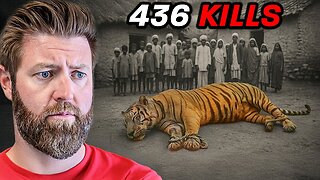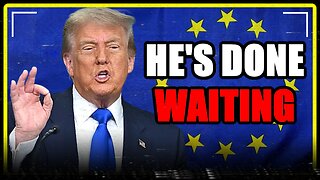Premium Only Content

Dalek Synopsis of the Crimean Invasion of 2014
Hello,
Today the Daleks present a precis of the work of Jonathon Cosgrov,
regarding the Crimean conflict of 2014.
Please don't subscribe, its a waste of your time.
1) The Russian invasion and annexation of Crimea was a crisis that heightened tensions between the world’s
two largest nuclear powers—the Russian Federation and the United States.
Despite explicit nuclear posturing, the episode in Crimea is often overlooked as a nuclear crisis,
being instead considered a crisis between Russia and Ukraine. But when analyzed as a confrontation
between Russia and the United States, the invasion of Crimea points to notable implications for the
nuclear balance, resolve, and crisis management.
Ukraine’s removal of Yanukovych from office saw Russia take immediate military action to
invade and occupy the Crimean Peninsula. In response, the United States sought to maintain
Ukraine’s territorial integrity. The crisis held a grave importance for Russia, which viewed
it less as a fight against Ukraine and more as a confrontation with the West over ground that
held deep military, national, cultural, and symbolic significance. Russia’s military gains on
the ground were maintained throughout the crisis under its threats to use nuclear weapons or
deploy nuclear weapons to the peninsula. Meanwhile, despite public disagreement among US policy
and military leaders, the United States’ responses remained diplomatic and economic.
In early 2014, the Russian Federation responded to the Euromaidan movement in the
Ukraine by invading, occupying, and annexing the Crimea.
Acting without markings and accompanied by official denials from the Kremlin,
Russian forces isolated and occupied Ukrainian political and military sites on the peninsula.
2) The Russian invasion and annexation of Crimea was a crisis that heightened tensions between the world’s
two largest nuclear powers—the Russian Federation and the United States.
Despite explicit nuclear posturing, the episode in Crimea is often overlooked as a nuclear crisis,
being instead considered a crisis between Russia and Ukraine. But when analyzed as a confrontation
between Russia and the United States, the invasion of Crimea points to notable implications for the
nuclear balance, resolve, and crisis management.
Ukraine’s removal of Yanukovych from office saw Russia take immediate military action to
invade and occupy the Crimean Peninsula. In response, the United States sought to maintain
Ukraine’s territorial integrity. The crisis held a grave importance for Russia, which viewed
it less as a fight against Ukraine and more as a confrontation with the West over ground that
held deep military, national, cultural, and symbolic significance. Russia’s military gains on
the ground were maintained throughout the crisis under its threats to use nuclear weapons or
deploy nuclear weapons to the peninsula. Meanwhile, despite public disagreement among US policy
and military leaders, the United States’ responses remained diplomatic and economic.
In early 2014, the Russian Federation responded to the Euromaidan movement in the
Ukraine by invading, occupying, and annexing the Crimea.
Acting without markings and accompanied by official denials from the Kremlin,
Russian forces isolated and occupied Ukrainian political and military sites on the peninsula.
3)
The International Crisis Behavior (ICB) project maintains the data set of record for the analysis of international crises.
This analysis deviates from the coding of the ICB data in two ways. First, the United States is considered to be an actor in
the crisis, making it a nuclear crisis between the Russian Federation and the United States.
Second, this analysis treats the Russian Federation’s invasion and annexation of the Crimean Peninsula as a crisis separate
from the war in the Donbass region of eastern Ukraine an ongoing conflict as of this writing.
In contrast, the ICB data codes the staggered invasion of Ukraine as a single crisis of Crimea-Donbass,
beginning with the removal of Ukrainian president Viktor Yanukovych on February 22, 2014, and ending with
the ejection of Ukrainian forces from Debaltseve on February 18, 2015.
4) The historical relationship between Ukraine and Russia is as deeply contentious as it is familial. Russia owes a significant
share of its cultural, religious, and political heritage to cities and regions in Ukraine. Both countries share political
parentage with the Kievan Rus, and the conversion of much of the Slavic world to Orthodox Christianity began in Crimea.
Soon after the Soviet system collapsed in Poland, Hungary, and Czechoslovakia, Ukraine declared sovereignty from the USSR
on July 16, 1990, followed a year later by a declaration of complete independence on August 24, 1991.
Driven by global anxiety around stability and the level of control over tactical nuclear arms scattered across the former
Soviet Union, Ukraine relinquished control of all the roughly three thousand inherited tactical nuclear weapons by May 1992.
After Ukrainian president Leonid Kuchma announced that Ukraine intended to pursue a NATO Membership Action Plan or MAP in
February 1992, the Russian parliament, Supreme Soviet of Russia, voted in May that the 1954 gifting of Crimea to the UkSSR was
illegitimate, making the peninsula an ongoing issue in negotiations.
Another peculiar element of the Russo-Ukrainian negotiations over Crimea was how Russia situated the city of Sevastopol
as a separate issue to be resolved. Russian parliamentary action in July 1993 declared that the port city was a part of Russia.
5) Ukrainian foreign relations through the late 1990s and 2000s were characterized by a balancing act between the
maintenance of cordial relations with Russia and the development of economic and political ties with the West.
This Westward drift included the pursuit of formal ties with NATO and the EU. In both cases, hopes of eventual
membership would be hindered by endemic corruption.
The 2004 presidential election between pro-Western Viktor Yushchenko and Viktor Yanukovych, who favored
closer ties to Moscow, brought the controversy to a boiling point. When Yanukovych’s initial victory was
revealed to be the result of election fraud, large popular protests against the results, that are now known as the
Orange Revolution, led to a runoff election, with Yushchenko emerging the winner in January 2005.
At a NATO summit in Bucharest, Putin warned that if Ukraine joined the alliance, it would risk losing Crimea
and eastern Ukraine. Later that year, in August 2008, Russia invaded Georgia, another prospective NATO member
from the former Soviet bloc.
6) Austerity measures the Yushchenko government had imposed to manage the economic damage were widely unpopular,
contributing to Yanukovych’s electoral victory in 2010. Yulia Tymoshenko narrowly lost the election to Yanukoych by 3.5 percent.
The Yanukovych administration withdrew Ukraine’s intent to pursue NATO membership, as well as cultural measures
favoring the Ukrainian language over Russian. In the most controversial action, Yanukovych and his party extended
Russia’s soon-to-expire lease of the port in Sevastopol to 2042 in exchange for energy discounts, sparking protests.
President Yanukovych persisted in pursuing an association agreement, referred to as the AA, with the EU, only seeking
observer status in the EAEU. By 2013, Yanukovych had consolidated significant political and economic power,
having prosecuted political rivals and built a powerful oligarchic network around himself.
By September 2013, Russia had successfully pivoted Armenia away from the EU and toward the Eurasian Customs Union
by threatening to raise natural gas prices and offering financial and security incentives. Similarly, Russia imposed
trade restrictions on Ukrainian goods with explicit threats of economic escalation.
7) Yanukovych refused to sign the AA at the Vilnius summit on November 28, where he met Angela Merkel in the
Knights hall of the Palace of the Grand Dukes of Lithuania.
The refusal to sign the AA immediately sparked protests in Kyiv’s Independence Square that
continued to escalate into a months-long saga of persistent demonstrations known as Euromaidan.
Days away from the culmination of the Euromaidan crisis, President Barack Obama condemned the
violence against protesters and imposed visa bans on twenty senior Ukrainian officials, threatening
more to come.
Russia’s primary goal through the Euromaidan crisis was to preserve and stabilize the rule of the
client Yanukovych regime.
Despite Russia’s efforts, Yanukovych finally signed a compromise with opposition leaders and fled
the country for Russia the night of February 21, and the Ukrainian parliament, the Verkhovna Rada
voted to impeach him on February 22.
8) On February 22, the same day Yanukovych was officially removed from office,
Spetsnaz of the Main Intelligence Directorate GRU were sent to Crimea to secure
strategic Russian facilities.
On February 26 Putin ordered snap military exercises in western Russia, and a landing
ship of the Russian Black Sea Fleet arrived in Sevastopol carrying two hundred special operations forces.
The new Ukrainian government officially summoned Russia’s diplomatic representation to explain the
military movements, but responses were delayed. Major troop landings and movements between Sevastopol
and Simferopol continued through February 28, including the seizure of Simferopol Airport.
President Obama issued a statement saying the United States was deeply concerned by reports of
military movements taken by the Russian Federation inside of Ukraine.
On March 1 the EU high representative for foreign affairs and security Catherine Ashton announced
that the EU deplored Russia’s decision to use military force in the Ukraine.
On March 1, the Federal Assembly of Russia approved Putin’s request to use force in Ukraine to
protect Russian interests.
9) The Supreme Council of Crimea declared the peninsula’s independence from the Ukraine on March 11.
The Russian Foreign Ministry pointed to the secession of Kosovo from Serbia as a legitimizing precedent
for the impending referendum.
On March 21, Putin signed the annexation of Crimea into Russian law. The seizure of all Ukrainian military
installations on the peninsula concluded over the next two days as Russian forces massed along Ukraine’s
northeastern border.
There were indications that Russian actions in Donbass alongside the crisis in Crimea sought to connect
separatist regions in eastern Ukraine to the peninsula as the new region of Novorossiya.
This analysis does not consider that effort to be an objective of the initial invasion of Crimea,
which was responsive to the removal of Viktor Yanukovych.
In summary, Russia emerged from the crisis in Crimea as the victor.
10)
Before the onset of Euromaidan and the crisis in Crimea, Russian military doctrine since 2000 allowed for a first-use nuclear response to large-scale aggression utilizing conventional weapons in situations critical to the national security of the Russian Federation.
By 2014, Russia maintained about 2,000 nonstrategic warheads, compared to 180 nonstrategic bombs maintained in theater by the United States.
This element of Russian military doctrine colored the crisis, serving to validate comments on nuclear first use and the movement of dual-use weapons.
The stated goal of the United States, alongside the EU, was to maintain the territorial integrity of Ukraine.
11) Russia’s earliest nuclear messaging against the United States and its later policy statements indicate that the Russian Federation
viewed the crises in Ukraine as tantamount to a confrontation with the United States and the EU.
Nevertheless, US and EU responses to the invasion of Crimea remained diplomatic and economic, restricted to statements of
condemnation and economic sanctions.
Statements of US senators and press reports on government officials’ comments indicate that the United States was
surprised by the invasion, suggesting that it was an intelligence failure.
President Obama implied a belief that, because Ukraine is a more central national interest to Russia than the United States,
Russia will always have more resolve in any competition for escalatory dominance.
The Russian Federation viewed the confrontation with greater gravity than the US or EU, held an advantage in the proximity of
conventional forces, and maintained nonstrategic nuclear superiority.
While the United States had overall nuclear superiority, it did not translate into greater resolve or victory.
The way in which Russia brandished its nonstrategic nuclear arsenal and first-use policy during the crisis in
Crimea should inform the policy community of how Russia might seek to intimidate and deter the United States in future crises.
The United States needs a strategic approach to deterring aggressive Russian revisionist actions in the future,
and that approach needs to account for the threat of nonstrategic nuclear weapons.
12) The International Crisis Behavior project protocol can be applied to the Crimean crisis.
Gravity is a variable that identifies the object of gravest threat at any time during the crisis,
as perceived by the principal decision makers of the crisis actor, coding the most severe value
threatened throughout the course of the crisis.
Proximity is a binary variable that measures which country is closer to the geographic location of
the crisis. The Crimea crisis occurred in Ukraine and along Russia’s southwestern border.
Population is a binary variable for the larger population size.
The Regime variable is usually expressed as a binary, with 1 for a more democratic government.
The government type is often assed using the Polity IV scale, with the United States as a Full Democracy
scoring a 10, while Russia is an Open Autocracy, with a score of 4.
The Second Strike variable concerns whether or not the actors possess forces able to assure a nuclear
response after absorbing an initial strike.
The Security variable controls for the possibility of states with underlying, long-standing disputes
that may be less likely to prevail in crises. According to this metric, the United States is less
secure than Russia.
The Violence variable measures intensity and ranges from 1, no violence, to 4, full-scale war.
When considering the crisis in Crimea, the United States did not use any force, while Russian forces
participated in what can be coded as 2, minor clashes.
References:
Frankel, Scouras, and Ullrich, Nonstrategic Nuclear Weapons at an Inflection Point, 25.
https://www.jhuapl.edu/Content/documents/NonstrategicNuclearWeapons.pdf
ICB Project:
https://sites.duke.edu/icbdata/
http://www.icb.umd.edu/dataviewer/
THE RUSSIAN INVASION OF THE CRIMEAN PENINSULA, 2014–2015
A Post–Cold War Nuclear Crisis Case Study
Jonathon Cosgrov 2020, The Johns Hopkins University Applied Physics Laboratory LLC.
https://www.jhuapl.edu/Content/documents/RussianInvasionCrimeanPeninsula.pdf
Polity IV's Democratic—Autocratic scale:
https://www.uni-heidelberg.de/md/politik/personal/schmidt/2015_schmidt_measuring_democracy_and_autocracy.pdf
https://www.jstor.org/stable/resrep14105.6?seq=1#metadata_info_tab_contents
-
 1:05:28
1:05:28
Man in America
8 hours agoTREASON? Obama, Hillary, and Soros in the New World Order Agenda EXPOSED w/ Mel K
49.7K11 -
 LIVE
LIVE
The Connect: With Johnny Mitchell
9 hours ago $0.11 earnedOne Man's Mission To Stop Human Trafficking: How A Billionaire Mercenary Saved Hundreds Of Children
436 watching -
 LIVE
LIVE
Tundra Tactical
4 hours ago $0.07 earned🔫 California Ammo Win, Sig Sauer P320 Controversy, Meme Review & Would You Rather! 🎉🔥
387 watching -
 16:24
16:24
Forrest Galante
2 hours ago6 Deadliest Man Eaters to Ever Exist
9.68K1 -
 10:14
10:14
MattMorseTV
6 hours ago $0.34 earnedThe EU is in HOT WATER.
67.9K36 -
 LIVE
LIVE
The Rabble Wrangler
1 day agoPUBG with The Best in the West!
95 watching -
 3:57:19
3:57:19
EvilT4000
5 hours agoSaturday.....🟢For energy and focus click my Dubby link!
9.32K1 -
 LIVE
LIVE
SlingerGames
1 hour agoSpartan Night - Halo and More | Creator for @SELFMADEGGS
40 watching -
 3:57:49
3:57:49
Mally_Mouse
7 hours agoSpicy Saturday!! - 10k CELEBRATION! - Let's Play: Labyrinthine
25.2K1 -
 37:09
37:09
The Mel K Show
8 hours agoMel K & Dr. Kirk Moore | A Doctor’s Oath: Doing What is Right No Matter the Cost | 7-26-25
26.7K10